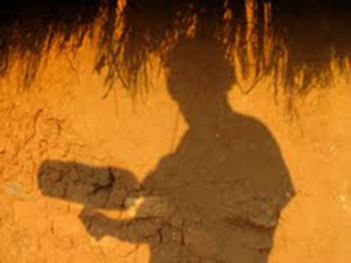“We Don’t Need No Stinking Pictures”

Only the shadow knows: Rob Rosenthal in Malawi
Brooke Powers
Radio documentary allows the story to tell itself. As Rob Rosenthal, an audio journalist stated, “we don’t need no stinking pictures.” The combination of ambient sound, the active tape recording of someone performing an action, and narration create a clear sense of the story. In this way the listener is the “coauthor” that visualizes the piece and engages with the work through this visualization. The audio piece that Rosenthal played at the beginning of his lecture – “Willie Young, Rabbit Hunter” — is an excellent example of how visualization is an active part of audio journalism. The piece featured sounds of fire crackling, the “whack” of a stick hitting the bunnies, and the interviewee’s voice. The fire crackling is an example of what Rosenthal labeled a “signature sound,” or a familiar sound that a listener can identify easily such as a siren or bell. These signature sounds are a key component to an audio piece’s success.
The ability to hear the intent behind someone’s words and the emotion that those words carry also attribute to the general success of audio journalism. The interview with the parents on either side of a terrible crime – “Witness to an Execution”– provides a terrific understanding of the weight words have in a story. As Rosenthal stated, audio journalism gives primacy to sound because of human’s innate storytelling ability. Emily Hsiao describes how her work — Leaving a Mark — had to be told through audio journalism in order to capture her banter with her subject and the turn that the story took in the middle of the interview. Audio journalism provides flexibility and versatility. Further, this mode of storytelling relates well to listeners because of an innate ability to tell stories audibly and interpret them as well.
-
Categories:
- Sociology